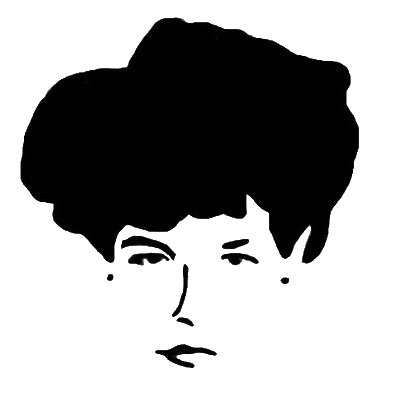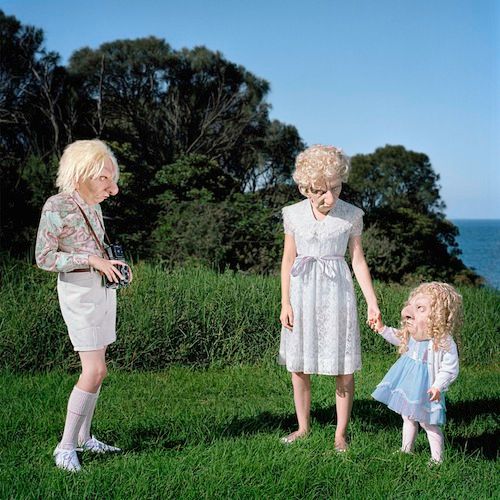
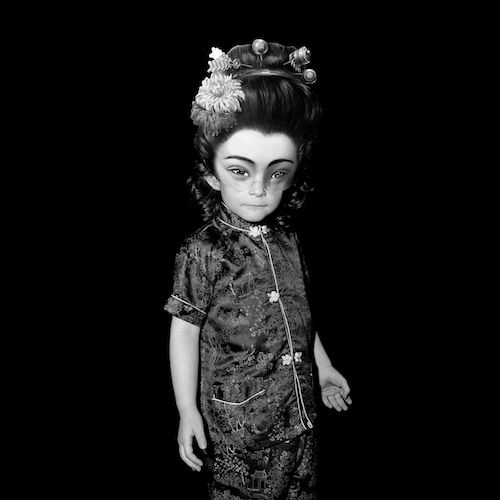
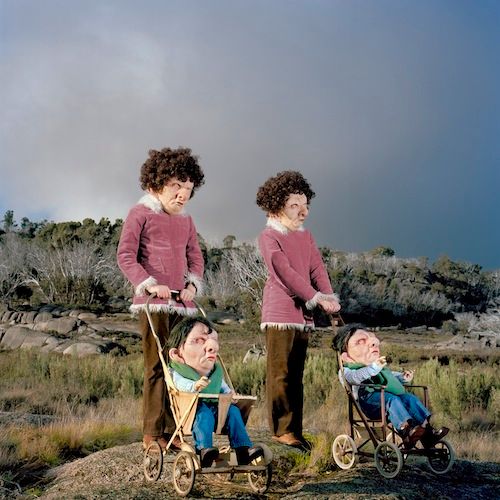
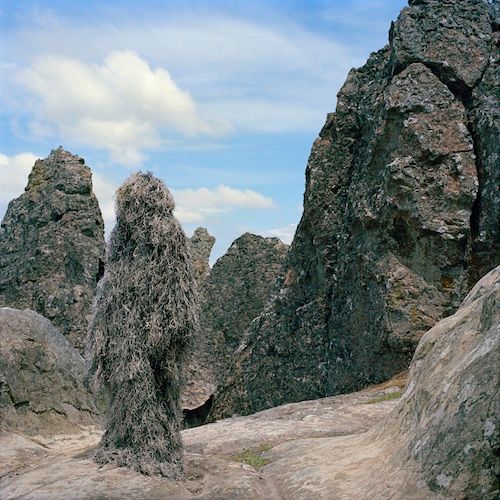
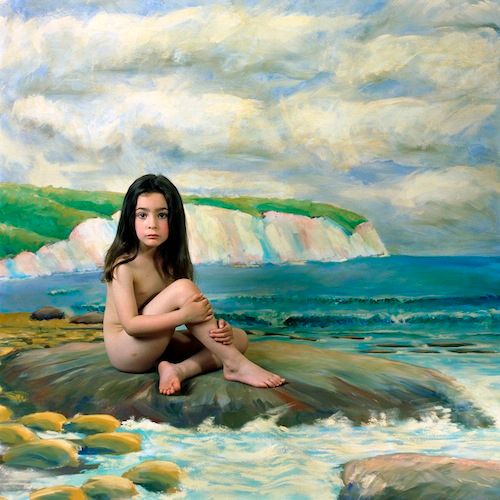
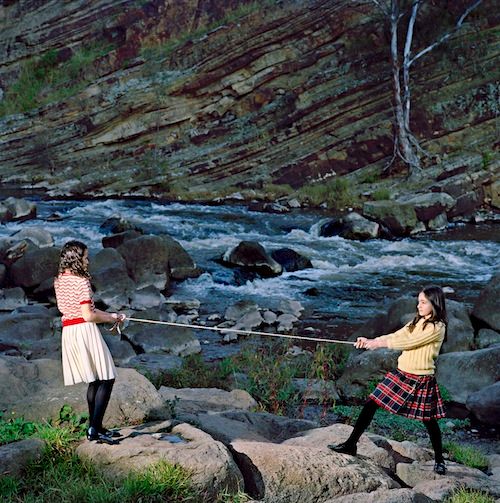

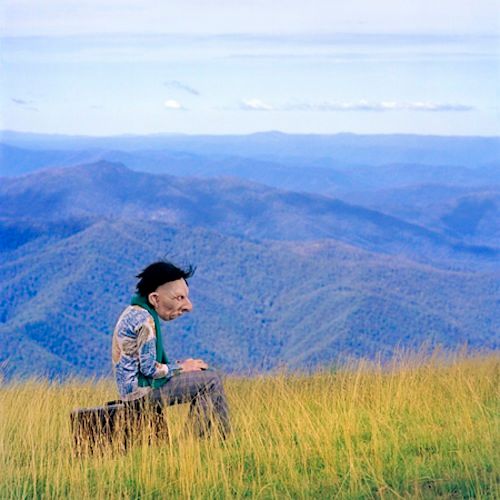
The daughter of Greek immigrants, Polixeni Papapetrou is an Australian-born photographer whose work has received international acclaim. She left her job as a lawyer when she was 41 to devote herself to photography, and since then she has produced a sensitive and visionary body of work. Papapetrou's two children, Olympia and Solomon, are the subjects of many of her photographs, often appearing in various states of disguise. In what she describes as a collaborative effort, they create images that are often described as dreamlike, surreal, and theatrical. To me, Papapetrou's photographs are like the best kind of children's stories, the ones in which children are the agents and designers of their own worlds. Papapetrou was diagnosed with terminal cancer in October and given only weeks to live. Since then, she's continued to work. Her most recent series features her son in various landscapes, wearing full-body costumes that, unbelievably, are actual Australian Army camouflage suits. This series, The Ghillies, will be exhibited at the Nellie Castan Gallery in March. A selection of her photographs will also be exhibited in New York, at the Jenkins Johnson Gallery, in April. Last month she answered a few questions via email from her home in Melbourne.
Amanda Shapiro: Your photography has evolved in fascinating ways over the course of your 25-year career. In particular, your subjects, often your two children, keep getting more and more camouflaged. Also you've moved from black backgrounds to painted sets to the vast Australian landscape. What are your thoughts about these particular evolutions?
Polixeni Papapetrou: Yes, it has evolved. It began by portraying different facets of identity construction, whether photographing drag queens, body builders, circus performers, clowns, Marilyn Monroe or Elvis impersonators; but here’s the rub: they’re all about masquerade and, in a sense, symbols. In 2002, I decided to focus on childhood (a byword for all things pure and natural) as having children acted as a catalyst towards this subject matter. Without planning this in advance I have explored my understanding of childhood through my children who I continue to photograph as adolescents; and all the while, as you suggest, they wear masks, arguably more and more inscrutably.
As the children grew older and their experience of the world was shifting from the imaginative interior world of dress-ups and make-believe at home to into a more pragmatic experience with the world beyond the home I moved the work from the realm of the home studio into the real world; though again it’s only partly really them. My idea was that children are other to adult in the same way that animals are other to human. I was curious to ask what separates human beings from animals and children from adults? I continued using the mask as a transformative device in ‘The Dreamkeepers’ where I tried to capture children caught in the awkward evolution of adolescence but aged beyond their years and mimicking roles from the adult world. I was collapsing notions of the otherness of children and the elderly into the one body.
In ‘The Gillies’, my son wears a ghillie suit (a camouflage outfit originally developed for hunting and the military) as he navigates the darker continent of the teens. The pictures are about the surrendering of childhood or boyhood to the adult world foreshadowing prowess, as young boys, separate from great maternal intimacy and are absorbed into institutional camouflage of one kind or another. In these photographs I wanted to speak both directly and metaphorically about boys, adolescence and identity and how they might reconcile their inner world with the social demands of the outer world during this phase. To me, that pillar of a boy is a boy in the unconscious. With all that garnish of institutional fluff, he is awesomely all that a boy has to be to become the complement of his mother.
AS: As a mother who uses her children in her art, you've faced some pretty intense criticism. Do you feel that you've responded to that criticism at all via your work? For example, you are clearly interested in society's ideas about childhood, but does that interest extend to motherhood?
PP: There was a brief spate of criticism from an uninformed audience when Australia made international headlines in 2008 over its moral panic over naked children in art. They were trying times, in which it was suggested by the country’s Prime Minister, no less, that children do not have the cognitive powers to consent meaningfully to whatever an artist sets them up for. Fortunately, these naïve positions were offset by more sober explanations of risk, theatre, film and art as well as the educational growth of young people involved in them. But certainly, you’re right: it uncovered a nerve, an underlying fear about being a bad mother. In fact, much of my work is an interrogation of childhood and its meanings, where romantic ideas of motherhood are unhelpful.
Even before the birth of my children I was interested in how our culture views childhood and moreover how the institution of childhood was created by the adult world and continues to be defined and redefined by adults. I think that our understanding of childhood is coloured by adult desires and expectations and it’s invested with qualities that adults want to see in children. My interest in photographing children has more to do with unnravelling ideas about childhood identity both from a historical and contemporary perspective—but also what the child might be in the unconscious—rather than looking at my relationship to my children per se. They sure don’t belong to a documentary genre. In dealing with this subject matter, I am conscious that on the one hand the work takes the viewer into the realms of fantasy and story telling, but on the other hand, it can challenge our expectations regarding the portrayal of children in photography. Perhaps my work has been criticized because I have not portrayed the child in a romanticized way. Since the advent of photography in the 19th century we have become accustomed to looking at romanticized pictures of children that reinforce the ideal of childhood innocence portraying them as symbols of innocence, fragility and vulnerability. Children have often thought of as exhibiting qualities that have been lost to adults, such as innocence, the capacity for wonder and so on and we expect to see this in the child. I guess that this is the reason that the 19th century romantic ideal persists today especially in advertising. I am interested in portraying the child as knowing and not objectifying the child’s image in order to make us feel comfortable in the viewing or by demeaning the child with a language of cuteness that fetishizes the powerlessness of the child. We want to see an idealized public image of the child and find the negative aspects of childhood, such as children being unreasonable, having tantrums, making a mess and so on confronting. Motherhood is a jealously guarded concept and I think that when a mother works with her children and creates artworks of them that may show them naked or as a knowing child, the work has the potential to cause a high level of anxiety in the community. It is as if the child has been turned over to objectification because some exclusive and private intimacy between mother and child has been breached. I would like to think that my artistic tradition is one that explores and celebrates childhood in its varied facets and experiences.
AS: It's not always a compliment to say that a certain novel is like a photograph, but it's quite an achievement when the reverse is true. To me, your photographs are first and foremost about stories. Every image could be a novel, it seems! And, on another level, the subjects themselves are often engaged in the process of storytelling, role-playing, and fantasy. What do you find interesting/unique about photography's ability to both create and document stories?
PP: Oh, first let me agree with the first part: in fact, I’m reassured by the suggestion, not so much of a rapprochement with literature as a similarity of method. Like a writer, I like to observe the world but then to think about how a picture of such phenomena could gain meaning and ‘speak’ of some general insight through the language of the picture. The pictures are ‘written’ (in the sense of Barthes’ écriture) by a common search for the poetic metaphor, what the image could capture symbolically by way of an existential moment. And of course, in concrete terms, the overlap between literature and photography is theatre and performance. For the Victorians, photography was not only considered as a direct and unmediated translation of reality—a purely mechanical reproduction of what the camera saw—but it also represented performance and theatre. This understanding of photography emanated from the Victorian interest in illusion, symbolism, the imaginary and theatre. I have never been very good at photographing the real world in the documentary tradition. I really admire the photographers who do this well because when I look at the unmediated world as I see it through my camera there is nothing that makes photographic sense to me. I think that this is because I have these characters in my mind and like to find the habitat for them and then photograph them. For me it is about reconciling my inner world, possibly the unconscious to the real world.
AS: According to ‘The Age’, you were diagnosed with cancer last fall and told you had very little time to live. Are you currently working now, and does the work (the creation or the product or both) feel different given your prognosis? Is there any photograph or series in particular that you hope to be remembered for?
PP: Yes sadly that’s right. In November 2012 my breast cancer suddenly returned without any symptoms as advanced metastases in the peritoneum. I have been making some pictures of my daughter dressed as a clown, but wearing a mask. I’ve always had an interest in the circus and in the late ‘80s to early ‘90s I spent a lot of time at the circus photographing clowns. I am interested in the clown as Other – and although I had been thinking about making clown pictures and went to the lengths to collect costumes and wigs I never got around to making this work. As I had the costumes and had sewn wigs on masks I felt compelled to realize some of my ideas. Normally when we think of a clown the classical image is a clown who wears a happy painted face, but beneath the paint there is an assumed feeling of melancholia or sadness. I thought that my daughter could wear a mask without any painted expression to reveal the face of the clown when they have removed the make-up, but the irony is that there is another mask behind the painted face. So she appears as a masked clown to make the point that no matter how many layers we take off, in many ways we mask our identity or selves. I am calling this body of work ‘Melancholia’. I thought ‘The Ghillies’ would be my last body of work, but somehow I rallied to make some more images of Olympia. Since the diagnosis of breast cancer in 2007 the children have appeared in the photographs wearing masks and I have been covering them up more and more, just as you said at the outset. Perhaps this can be read as a disappearance of sorts. Since the initial diagnosis, I have felt a shift in my work in that I relied less on pre-existing scripts and narratives and decided to create work that arose from my imagination and which proposes greater access to the unconscious. I began to work in a more intuitive and organic way. I don’t know which work or series that I will be remembered for or whether I have a particular favourite. I did enjoy making ‘The Dreamkeepers’ which I consider to be the most human of all my pictures, although some people have found it confronting.
